University Project: Vodafone's No-Lock Plans and Sales Enhancement
VerifiedAdded on 2022/10/19
|13
|3827
|111
Report
AI Summary
This report provides a comprehensive literature review and analysis of Vodafone's strategy to increase sales through the introduction of no-lock SIM and phone plans. The report delves into the theoretical underpinnings, exploring how Vodafone, through its parent companies, has adapted to the competitive telecommunications market by offering innovative features. It examines existing theories on the impact of new features on SIM cards and phones and also explores the company's historical development. The empirical review analyzes the impact of monthly handset and SIM payment fees, exclusive benefits of no-lock contracts, and the factors that encourage consumers to opt for these plans. The report also identifies research gaps and presents a conceptual framework, supported by secondary sources. It highlights the importance of factors like time, product impact on customer lifestyle, and competitor actions. The report emphasizes the advantages of no-lock plans, including cost-effectiveness, consumer trust, and transparency. Overall, the report provides a detailed insight into the strategies employed by Vodafone to gain a competitive edge in the telecommunications industry.
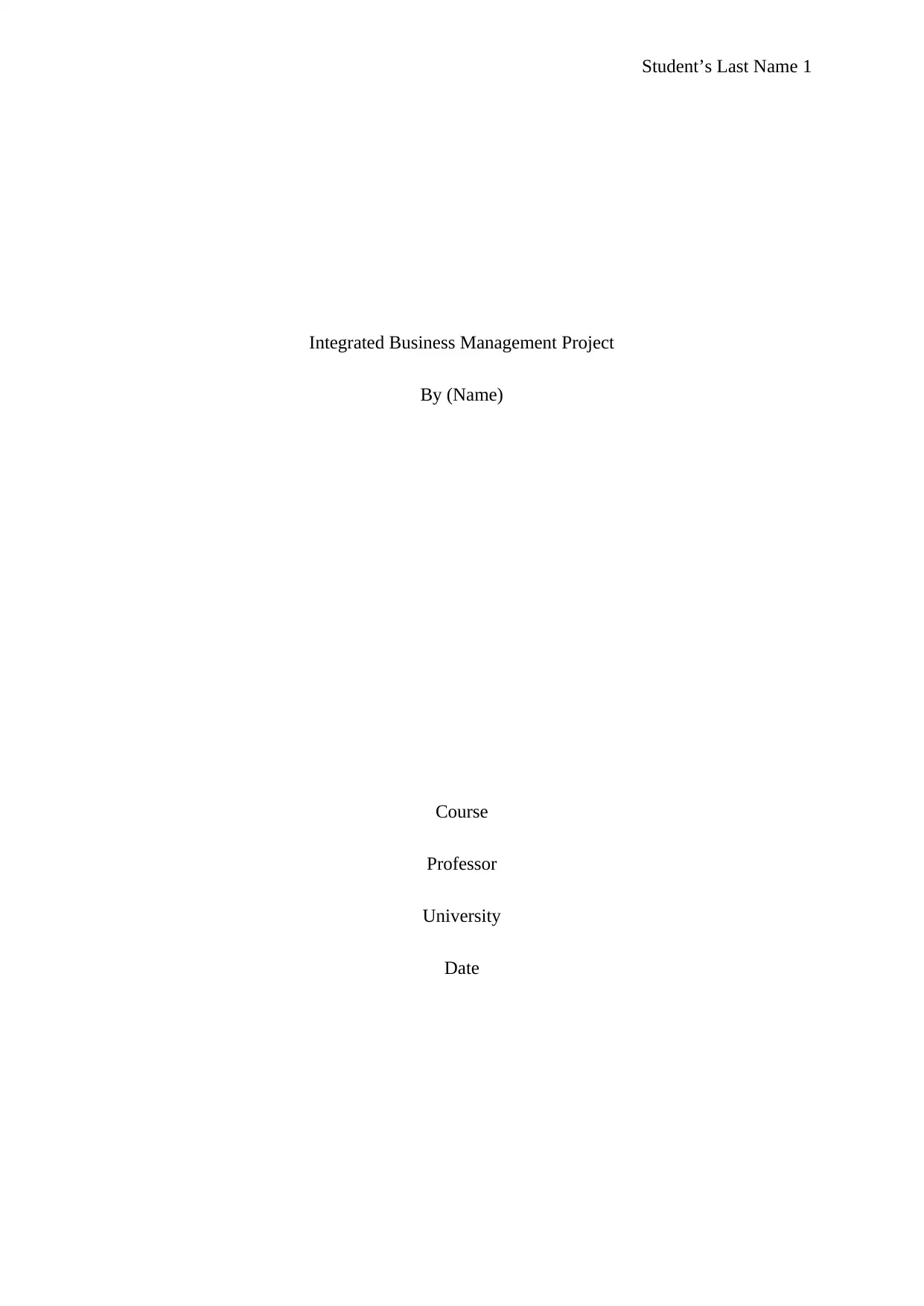
Student’s Last Name 1
Integrated Business Management Project
By (Name)
Course
Professor
University
Date
Integrated Business Management Project
By (Name)
Course
Professor
University
Date
Paraphrase This Document
Need a fresh take? Get an instant paraphrase of this document with our AI Paraphraser
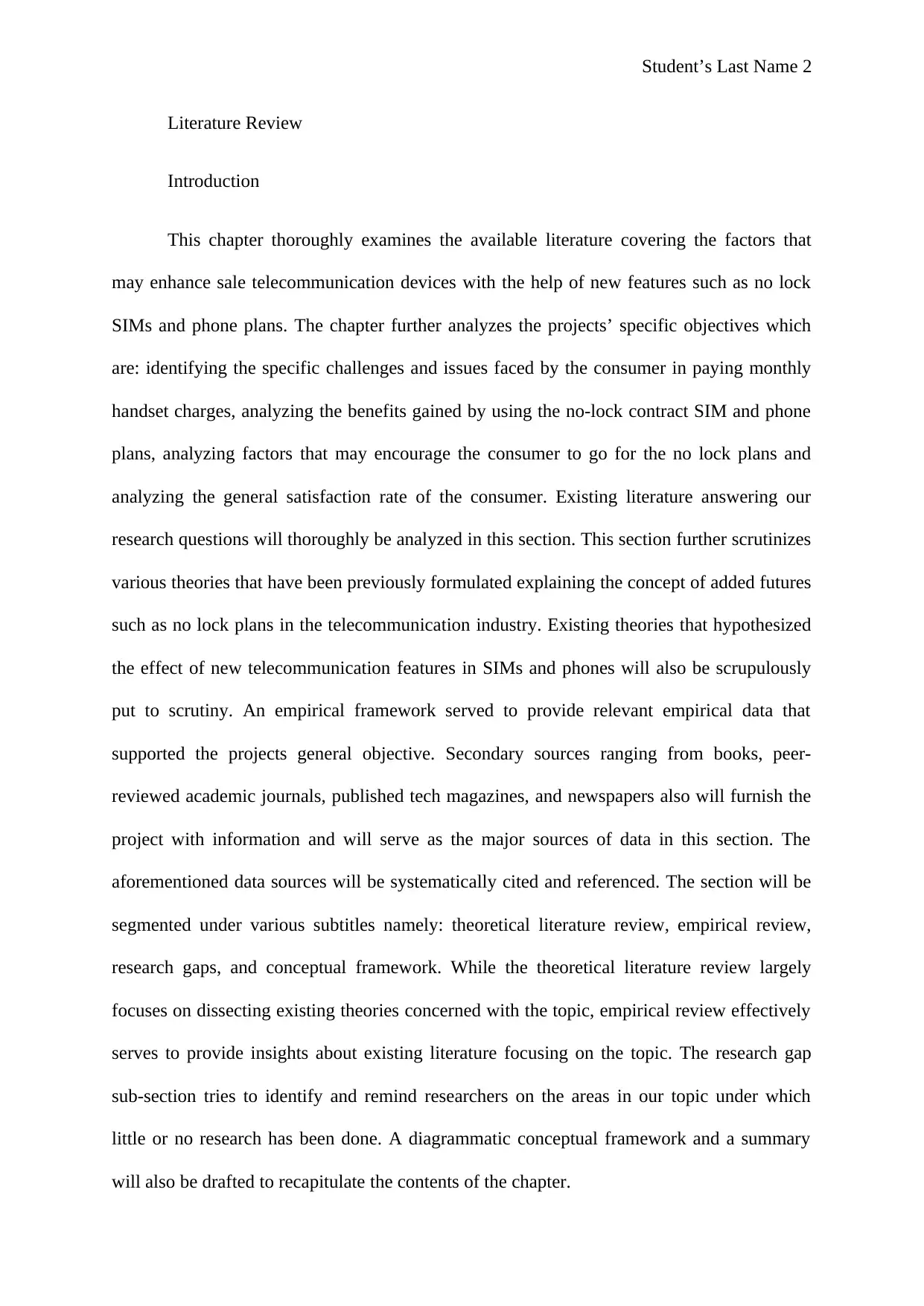
Student’s Last Name 2
Literature Review
Introduction
This chapter thoroughly examines the available literature covering the factors that
may enhance sale telecommunication devices with the help of new features such as no lock
SIMs and phone plans. The chapter further analyzes the projects’ specific objectives which
are: identifying the specific challenges and issues faced by the consumer in paying monthly
handset charges, analyzing the benefits gained by using the no-lock contract SIM and phone
plans, analyzing factors that may encourage the consumer to go for the no lock plans and
analyzing the general satisfaction rate of the consumer. Existing literature answering our
research questions will thoroughly be analyzed in this section. This section further scrutinizes
various theories that have been previously formulated explaining the concept of added futures
such as no lock plans in the telecommunication industry. Existing theories that hypothesized
the effect of new telecommunication features in SIMs and phones will also be scrupulously
put to scrutiny. An empirical framework served to provide relevant empirical data that
supported the projects general objective. Secondary sources ranging from books, peer-
reviewed academic journals, published tech magazines, and newspapers also will furnish the
project with information and will serve as the major sources of data in this section. The
aforementioned data sources will be systematically cited and referenced. The section will be
segmented under various subtitles namely: theoretical literature review, empirical review,
research gaps, and conceptual framework. While the theoretical literature review largely
focuses on dissecting existing theories concerned with the topic, empirical review effectively
serves to provide insights about existing literature focusing on the topic. The research gap
sub-section tries to identify and remind researchers on the areas in our topic under which
little or no research has been done. A diagrammatic conceptual framework and a summary
will also be drafted to recapitulate the contents of the chapter.
Literature Review
Introduction
This chapter thoroughly examines the available literature covering the factors that
may enhance sale telecommunication devices with the help of new features such as no lock
SIMs and phone plans. The chapter further analyzes the projects’ specific objectives which
are: identifying the specific challenges and issues faced by the consumer in paying monthly
handset charges, analyzing the benefits gained by using the no-lock contract SIM and phone
plans, analyzing factors that may encourage the consumer to go for the no lock plans and
analyzing the general satisfaction rate of the consumer. Existing literature answering our
research questions will thoroughly be analyzed in this section. This section further scrutinizes
various theories that have been previously formulated explaining the concept of added futures
such as no lock plans in the telecommunication industry. Existing theories that hypothesized
the effect of new telecommunication features in SIMs and phones will also be scrupulously
put to scrutiny. An empirical framework served to provide relevant empirical data that
supported the projects general objective. Secondary sources ranging from books, peer-
reviewed academic journals, published tech magazines, and newspapers also will furnish the
project with information and will serve as the major sources of data in this section. The
aforementioned data sources will be systematically cited and referenced. The section will be
segmented under various subtitles namely: theoretical literature review, empirical review,
research gaps, and conceptual framework. While the theoretical literature review largely
focuses on dissecting existing theories concerned with the topic, empirical review effectively
serves to provide insights about existing literature focusing on the topic. The research gap
sub-section tries to identify and remind researchers on the areas in our topic under which
little or no research has been done. A diagrammatic conceptual framework and a summary
will also be drafted to recapitulate the contents of the chapter.
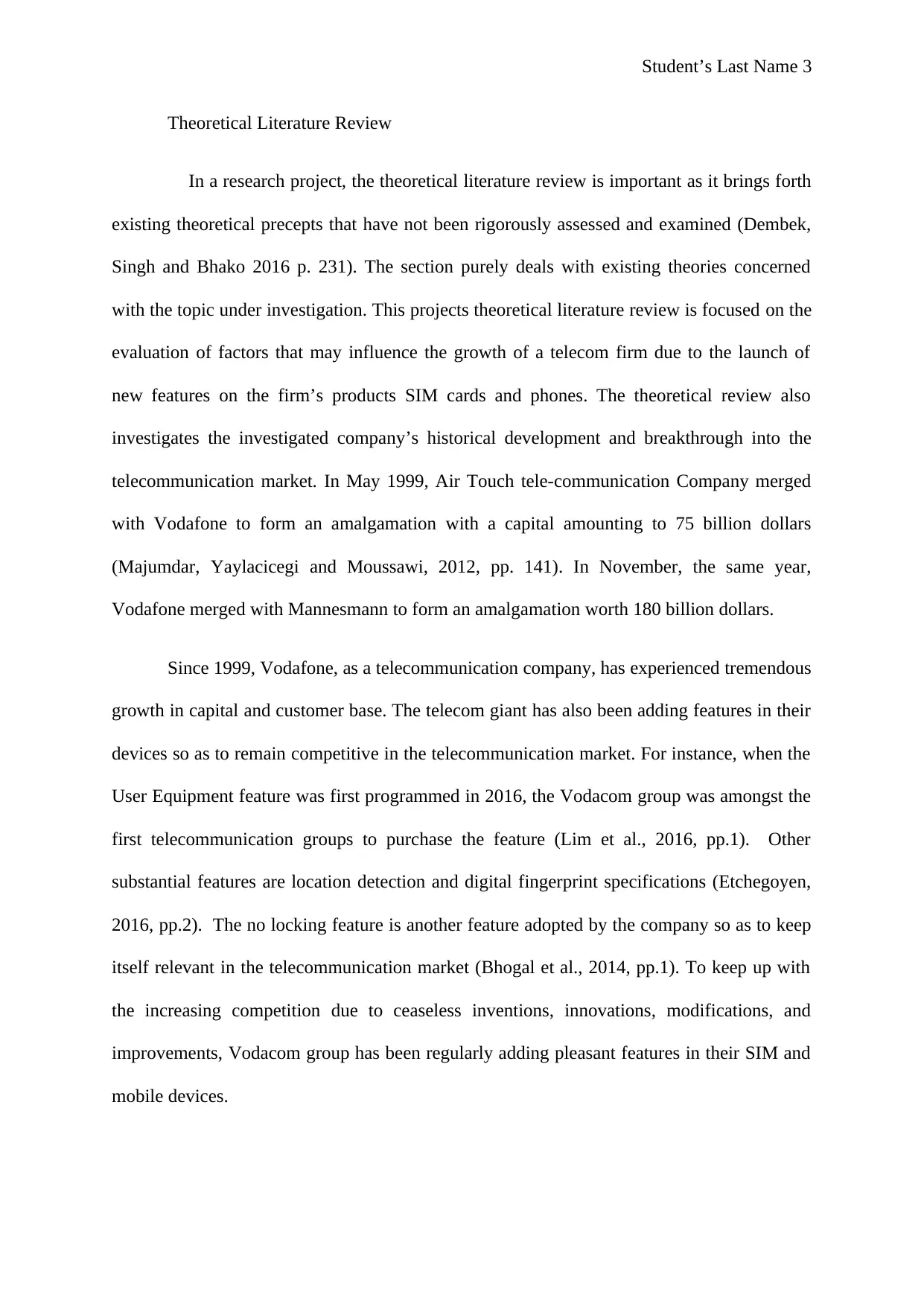
Student’s Last Name 3
Theoretical Literature Review
In a research project, the theoretical literature review is important as it brings forth
existing theoretical precepts that have not been rigorously assessed and examined (Dembek,
Singh and Bhako 2016 p. 231). The section purely deals with existing theories concerned
with the topic under investigation. This projects theoretical literature review is focused on the
evaluation of factors that may influence the growth of a telecom firm due to the launch of
new features on the firm’s products SIM cards and phones. The theoretical review also
investigates the investigated company’s historical development and breakthrough into the
telecommunication market. In May 1999, Air Touch tele-communication Company merged
with Vodafone to form an amalgamation with a capital amounting to 75 billion dollars
(Majumdar, Yaylacicegi and Moussawi, 2012, pp. 141). In November, the same year,
Vodafone merged with Mannesmann to form an amalgamation worth 180 billion dollars.
Since 1999, Vodafone, as a telecommunication company, has experienced tremendous
growth in capital and customer base. The telecom giant has also been adding features in their
devices so as to remain competitive in the telecommunication market. For instance, when the
User Equipment feature was first programmed in 2016, the Vodacom group was amongst the
first telecommunication groups to purchase the feature (Lim et al., 2016, pp.1). Other
substantial features are location detection and digital fingerprint specifications (Etchegoyen,
2016, pp.2). The no locking feature is another feature adopted by the company so as to keep
itself relevant in the telecommunication market (Bhogal et al., 2014, pp.1). To keep up with
the increasing competition due to ceaseless inventions, innovations, modifications, and
improvements, Vodacom group has been regularly adding pleasant features in their SIM and
mobile devices.
Theoretical Literature Review
In a research project, the theoretical literature review is important as it brings forth
existing theoretical precepts that have not been rigorously assessed and examined (Dembek,
Singh and Bhako 2016 p. 231). The section purely deals with existing theories concerned
with the topic under investigation. This projects theoretical literature review is focused on the
evaluation of factors that may influence the growth of a telecom firm due to the launch of
new features on the firm’s products SIM cards and phones. The theoretical review also
investigates the investigated company’s historical development and breakthrough into the
telecommunication market. In May 1999, Air Touch tele-communication Company merged
with Vodafone to form an amalgamation with a capital amounting to 75 billion dollars
(Majumdar, Yaylacicegi and Moussawi, 2012, pp. 141). In November, the same year,
Vodafone merged with Mannesmann to form an amalgamation worth 180 billion dollars.
Since 1999, Vodafone, as a telecommunication company, has experienced tremendous
growth in capital and customer base. The telecom giant has also been adding features in their
devices so as to remain competitive in the telecommunication market. For instance, when the
User Equipment feature was first programmed in 2016, the Vodacom group was amongst the
first telecommunication groups to purchase the feature (Lim et al., 2016, pp.1). Other
substantial features are location detection and digital fingerprint specifications (Etchegoyen,
2016, pp.2). The no locking feature is another feature adopted by the company so as to keep
itself relevant in the telecommunication market (Bhogal et al., 2014, pp.1). To keep up with
the increasing competition due to ceaseless inventions, innovations, modifications, and
improvements, Vodacom group has been regularly adding pleasant features in their SIM and
mobile devices.
⊘ This is a preview!⊘
Do you want full access?
Subscribe today to unlock all pages.

Trusted by 1+ million students worldwide
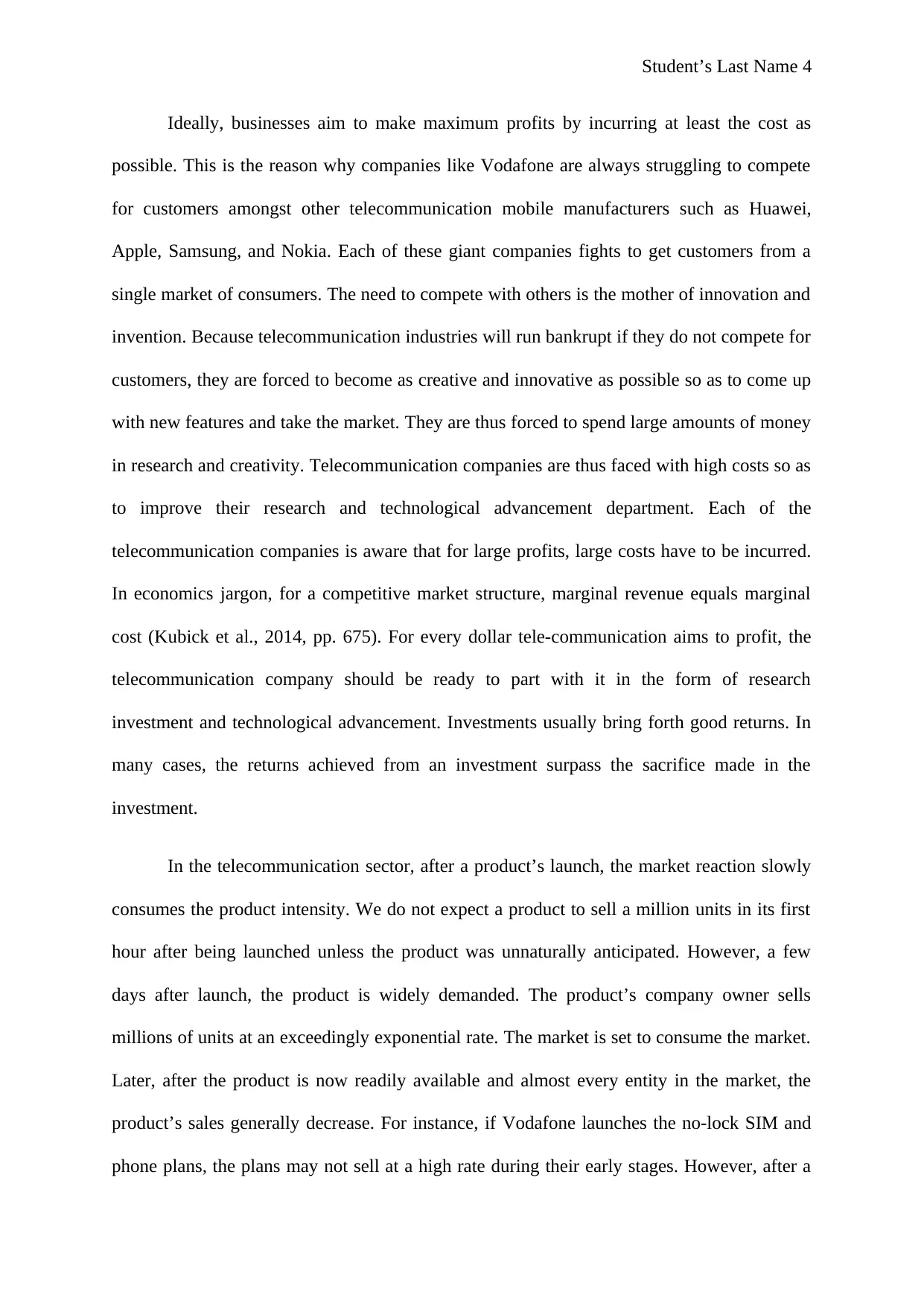
Student’s Last Name 4
Ideally, businesses aim to make maximum profits by incurring at least the cost as
possible. This is the reason why companies like Vodafone are always struggling to compete
for customers amongst other telecommunication mobile manufacturers such as Huawei,
Apple, Samsung, and Nokia. Each of these giant companies fights to get customers from a
single market of consumers. The need to compete with others is the mother of innovation and
invention. Because telecommunication industries will run bankrupt if they do not compete for
customers, they are forced to become as creative and innovative as possible so as to come up
with new features and take the market. They are thus forced to spend large amounts of money
in research and creativity. Telecommunication companies are thus faced with high costs so as
to improve their research and technological advancement department. Each of the
telecommunication companies is aware that for large profits, large costs have to be incurred.
In economics jargon, for a competitive market structure, marginal revenue equals marginal
cost (Kubick et al., 2014, pp. 675). For every dollar tele-communication aims to profit, the
telecommunication company should be ready to part with it in the form of research
investment and technological advancement. Investments usually bring forth good returns. In
many cases, the returns achieved from an investment surpass the sacrifice made in the
investment.
In the telecommunication sector, after a product’s launch, the market reaction slowly
consumes the product intensity. We do not expect a product to sell a million units in its first
hour after being launched unless the product was unnaturally anticipated. However, a few
days after launch, the product is widely demanded. The product’s company owner sells
millions of units at an exceedingly exponential rate. The market is set to consume the market.
Later, after the product is now readily available and almost every entity in the market, the
product’s sales generally decrease. For instance, if Vodafone launches the no-lock SIM and
phone plans, the plans may not sell at a high rate during their early stages. However, after a
Ideally, businesses aim to make maximum profits by incurring at least the cost as
possible. This is the reason why companies like Vodafone are always struggling to compete
for customers amongst other telecommunication mobile manufacturers such as Huawei,
Apple, Samsung, and Nokia. Each of these giant companies fights to get customers from a
single market of consumers. The need to compete with others is the mother of innovation and
invention. Because telecommunication industries will run bankrupt if they do not compete for
customers, they are forced to become as creative and innovative as possible so as to come up
with new features and take the market. They are thus forced to spend large amounts of money
in research and creativity. Telecommunication companies are thus faced with high costs so as
to improve their research and technological advancement department. Each of the
telecommunication companies is aware that for large profits, large costs have to be incurred.
In economics jargon, for a competitive market structure, marginal revenue equals marginal
cost (Kubick et al., 2014, pp. 675). For every dollar tele-communication aims to profit, the
telecommunication company should be ready to part with it in the form of research
investment and technological advancement. Investments usually bring forth good returns. In
many cases, the returns achieved from an investment surpass the sacrifice made in the
investment.
In the telecommunication sector, after a product’s launch, the market reaction slowly
consumes the product intensity. We do not expect a product to sell a million units in its first
hour after being launched unless the product was unnaturally anticipated. However, a few
days after launch, the product is widely demanded. The product’s company owner sells
millions of units at an exceedingly exponential rate. The market is set to consume the market.
Later, after the product is now readily available and almost every entity in the market, the
product’s sales generally decrease. For instance, if Vodafone launches the no-lock SIM and
phone plans, the plans may not sell at a high rate during their early stages. However, after a
Paraphrase This Document
Need a fresh take? Get an instant paraphrase of this document with our AI Paraphraser
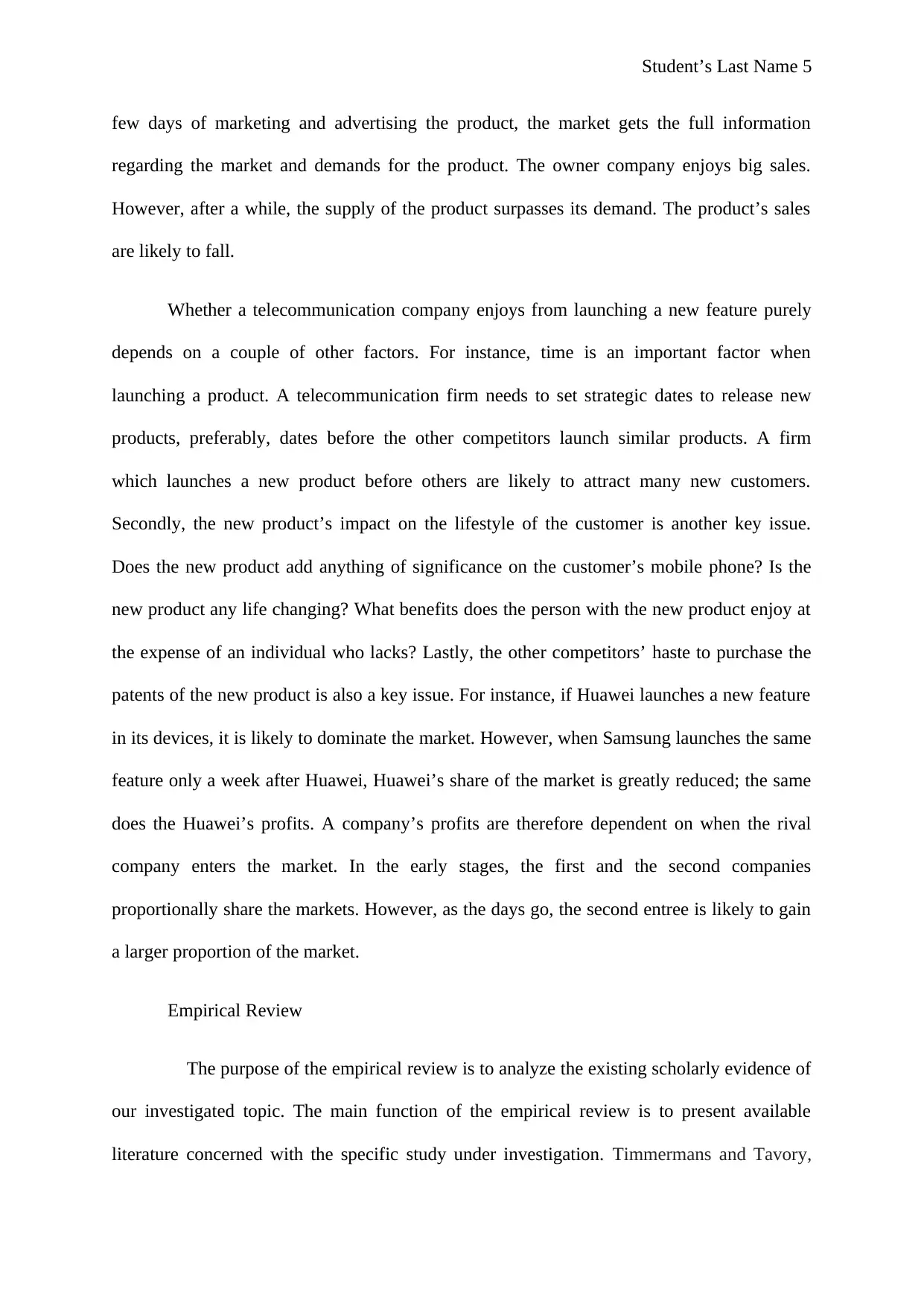
Student’s Last Name 5
few days of marketing and advertising the product, the market gets the full information
regarding the market and demands for the product. The owner company enjoys big sales.
However, after a while, the supply of the product surpasses its demand. The product’s sales
are likely to fall.
Whether a telecommunication company enjoys from launching a new feature purely
depends on a couple of other factors. For instance, time is an important factor when
launching a product. A telecommunication firm needs to set strategic dates to release new
products, preferably, dates before the other competitors launch similar products. A firm
which launches a new product before others are likely to attract many new customers.
Secondly, the new product’s impact on the lifestyle of the customer is another key issue.
Does the new product add anything of significance on the customer’s mobile phone? Is the
new product any life changing? What benefits does the person with the new product enjoy at
the expense of an individual who lacks? Lastly, the other competitors’ haste to purchase the
patents of the new product is also a key issue. For instance, if Huawei launches a new feature
in its devices, it is likely to dominate the market. However, when Samsung launches the same
feature only a week after Huawei, Huawei’s share of the market is greatly reduced; the same
does the Huawei’s profits. A company’s profits are therefore dependent on when the rival
company enters the market. In the early stages, the first and the second companies
proportionally share the markets. However, as the days go, the second entree is likely to gain
a larger proportion of the market.
Empirical Review
The purpose of the empirical review is to analyze the existing scholarly evidence of
our investigated topic. The main function of the empirical review is to present available
literature concerned with the specific study under investigation. Timmermans and Tavory,
few days of marketing and advertising the product, the market gets the full information
regarding the market and demands for the product. The owner company enjoys big sales.
However, after a while, the supply of the product surpasses its demand. The product’s sales
are likely to fall.
Whether a telecommunication company enjoys from launching a new feature purely
depends on a couple of other factors. For instance, time is an important factor when
launching a product. A telecommunication firm needs to set strategic dates to release new
products, preferably, dates before the other competitors launch similar products. A firm
which launches a new product before others are likely to attract many new customers.
Secondly, the new product’s impact on the lifestyle of the customer is another key issue.
Does the new product add anything of significance on the customer’s mobile phone? Is the
new product any life changing? What benefits does the person with the new product enjoy at
the expense of an individual who lacks? Lastly, the other competitors’ haste to purchase the
patents of the new product is also a key issue. For instance, if Huawei launches a new feature
in its devices, it is likely to dominate the market. However, when Samsung launches the same
feature only a week after Huawei, Huawei’s share of the market is greatly reduced; the same
does the Huawei’s profits. A company’s profits are therefore dependent on when the rival
company enters the market. In the early stages, the first and the second companies
proportionally share the markets. However, as the days go, the second entree is likely to gain
a larger proportion of the market.
Empirical Review
The purpose of the empirical review is to analyze the existing scholarly evidence of
our investigated topic. The main function of the empirical review is to present available
literature concerned with the specific study under investigation. Timmermans and Tavory,
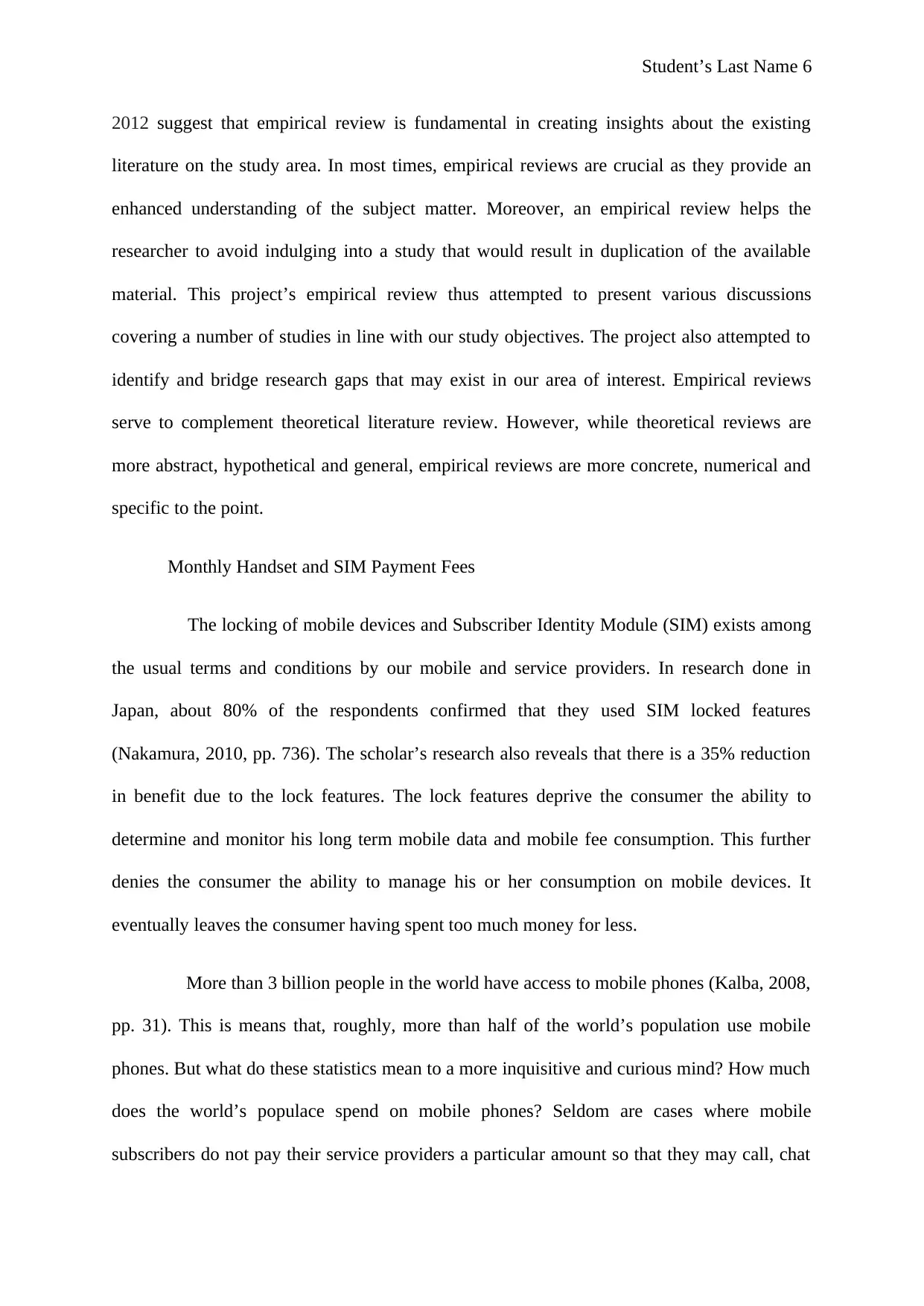
Student’s Last Name 6
2012 suggest that empirical review is fundamental in creating insights about the existing
literature on the study area. In most times, empirical reviews are crucial as they provide an
enhanced understanding of the subject matter. Moreover, an empirical review helps the
researcher to avoid indulging into a study that would result in duplication of the available
material. This project’s empirical review thus attempted to present various discussions
covering a number of studies in line with our study objectives. The project also attempted to
identify and bridge research gaps that may exist in our area of interest. Empirical reviews
serve to complement theoretical literature review. However, while theoretical reviews are
more abstract, hypothetical and general, empirical reviews are more concrete, numerical and
specific to the point.
Monthly Handset and SIM Payment Fees
The locking of mobile devices and Subscriber Identity Module (SIM) exists among
the usual terms and conditions by our mobile and service providers. In research done in
Japan, about 80% of the respondents confirmed that they used SIM locked features
(Nakamura, 2010, pp. 736). The scholar’s research also reveals that there is a 35% reduction
in benefit due to the lock features. The lock features deprive the consumer the ability to
determine and monitor his long term mobile data and mobile fee consumption. This further
denies the consumer the ability to manage his or her consumption on mobile devices. It
eventually leaves the consumer having spent too much money for less.
More than 3 billion people in the world have access to mobile phones (Kalba, 2008,
pp. 31). This is means that, roughly, more than half of the world’s population use mobile
phones. But what do these statistics mean to a more inquisitive and curious mind? How much
does the world’s populace spend on mobile phones? Seldom are cases where mobile
subscribers do not pay their service providers a particular amount so that they may call, chat
2012 suggest that empirical review is fundamental in creating insights about the existing
literature on the study area. In most times, empirical reviews are crucial as they provide an
enhanced understanding of the subject matter. Moreover, an empirical review helps the
researcher to avoid indulging into a study that would result in duplication of the available
material. This project’s empirical review thus attempted to present various discussions
covering a number of studies in line with our study objectives. The project also attempted to
identify and bridge research gaps that may exist in our area of interest. Empirical reviews
serve to complement theoretical literature review. However, while theoretical reviews are
more abstract, hypothetical and general, empirical reviews are more concrete, numerical and
specific to the point.
Monthly Handset and SIM Payment Fees
The locking of mobile devices and Subscriber Identity Module (SIM) exists among
the usual terms and conditions by our mobile and service providers. In research done in
Japan, about 80% of the respondents confirmed that they used SIM locked features
(Nakamura, 2010, pp. 736). The scholar’s research also reveals that there is a 35% reduction
in benefit due to the lock features. The lock features deprive the consumer the ability to
determine and monitor his long term mobile data and mobile fee consumption. This further
denies the consumer the ability to manage his or her consumption on mobile devices. It
eventually leaves the consumer having spent too much money for less.
More than 3 billion people in the world have access to mobile phones (Kalba, 2008,
pp. 31). This is means that, roughly, more than half of the world’s population use mobile
phones. But what do these statistics mean to a more inquisitive and curious mind? How much
does the world’s populace spend on mobile phones? Seldom are cases where mobile
subscribers do not pay their service providers a particular amount so that they may call, chat
⊘ This is a preview!⊘
Do you want full access?
Subscribe today to unlock all pages.

Trusted by 1+ million students worldwide
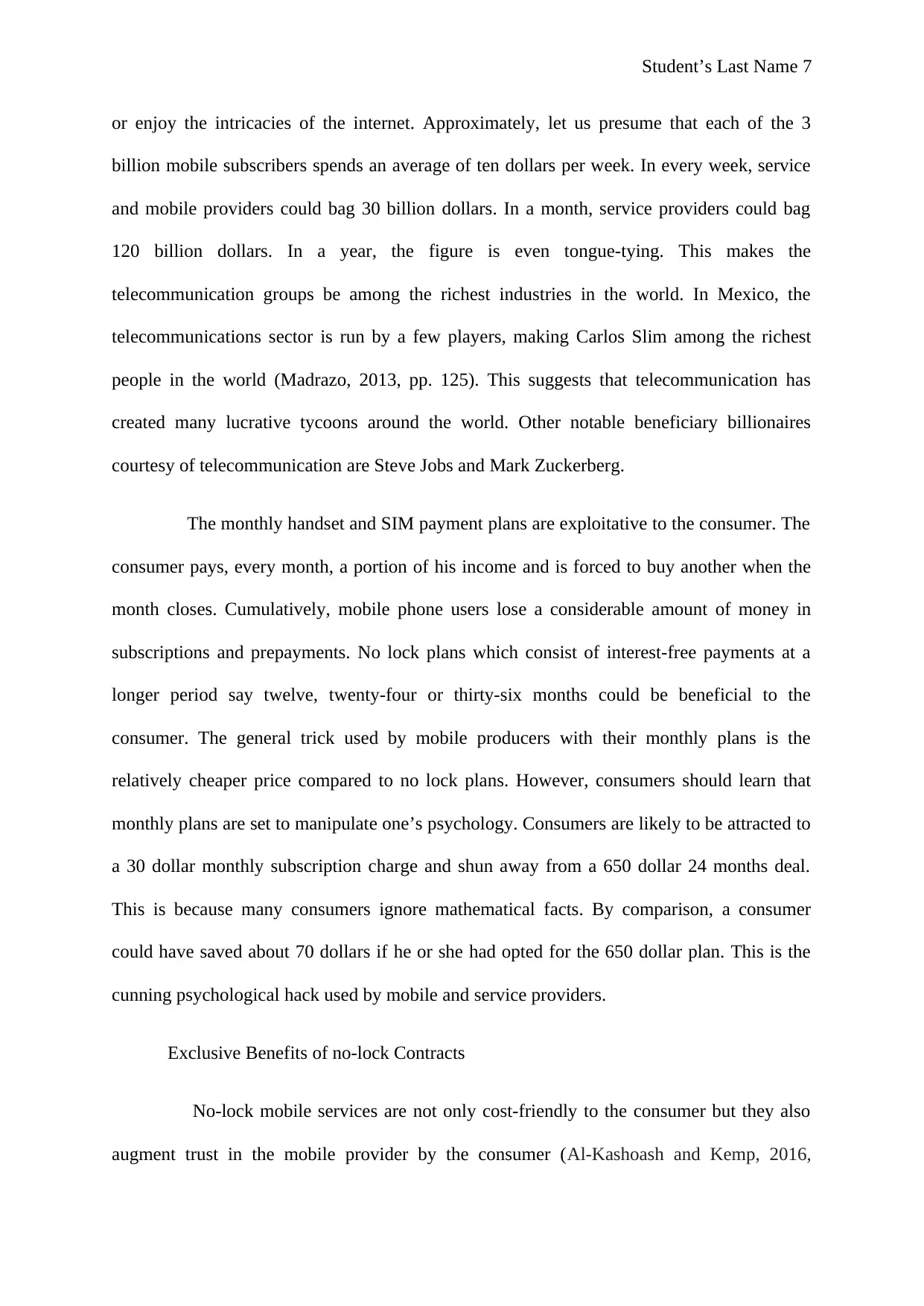
Student’s Last Name 7
or enjoy the intricacies of the internet. Approximately, let us presume that each of the 3
billion mobile subscribers spends an average of ten dollars per week. In every week, service
and mobile providers could bag 30 billion dollars. In a month, service providers could bag
120 billion dollars. In a year, the figure is even tongue-tying. This makes the
telecommunication groups be among the richest industries in the world. In Mexico, the
telecommunications sector is run by a few players, making Carlos Slim among the richest
people in the world (Madrazo, 2013, pp. 125). This suggests that telecommunication has
created many lucrative tycoons around the world. Other notable beneficiary billionaires
courtesy of telecommunication are Steve Jobs and Mark Zuckerberg.
The monthly handset and SIM payment plans are exploitative to the consumer. The
consumer pays, every month, a portion of his income and is forced to buy another when the
month closes. Cumulatively, mobile phone users lose a considerable amount of money in
subscriptions and prepayments. No lock plans which consist of interest-free payments at a
longer period say twelve, twenty-four or thirty-six months could be beneficial to the
consumer. The general trick used by mobile producers with their monthly plans is the
relatively cheaper price compared to no lock plans. However, consumers should learn that
monthly plans are set to manipulate one’s psychology. Consumers are likely to be attracted to
a 30 dollar monthly subscription charge and shun away from a 650 dollar 24 months deal.
This is because many consumers ignore mathematical facts. By comparison, a consumer
could have saved about 70 dollars if he or she had opted for the 650 dollar plan. This is the
cunning psychological hack used by mobile and service providers.
Exclusive Benefits of no-lock Contracts
No-lock mobile services are not only cost-friendly to the consumer but they also
augment trust in the mobile provider by the consumer (Al-Kashoash and Kemp, 2016,
or enjoy the intricacies of the internet. Approximately, let us presume that each of the 3
billion mobile subscribers spends an average of ten dollars per week. In every week, service
and mobile providers could bag 30 billion dollars. In a month, service providers could bag
120 billion dollars. In a year, the figure is even tongue-tying. This makes the
telecommunication groups be among the richest industries in the world. In Mexico, the
telecommunications sector is run by a few players, making Carlos Slim among the richest
people in the world (Madrazo, 2013, pp. 125). This suggests that telecommunication has
created many lucrative tycoons around the world. Other notable beneficiary billionaires
courtesy of telecommunication are Steve Jobs and Mark Zuckerberg.
The monthly handset and SIM payment plans are exploitative to the consumer. The
consumer pays, every month, a portion of his income and is forced to buy another when the
month closes. Cumulatively, mobile phone users lose a considerable amount of money in
subscriptions and prepayments. No lock plans which consist of interest-free payments at a
longer period say twelve, twenty-four or thirty-six months could be beneficial to the
consumer. The general trick used by mobile producers with their monthly plans is the
relatively cheaper price compared to no lock plans. However, consumers should learn that
monthly plans are set to manipulate one’s psychology. Consumers are likely to be attracted to
a 30 dollar monthly subscription charge and shun away from a 650 dollar 24 months deal.
This is because many consumers ignore mathematical facts. By comparison, a consumer
could have saved about 70 dollars if he or she had opted for the 650 dollar plan. This is the
cunning psychological hack used by mobile and service providers.
Exclusive Benefits of no-lock Contracts
No-lock mobile services are not only cost-friendly to the consumer but they also
augment trust in the mobile provider by the consumer (Al-Kashoash and Kemp, 2016,
Paraphrase This Document
Need a fresh take? Get an instant paraphrase of this document with our AI Paraphraser
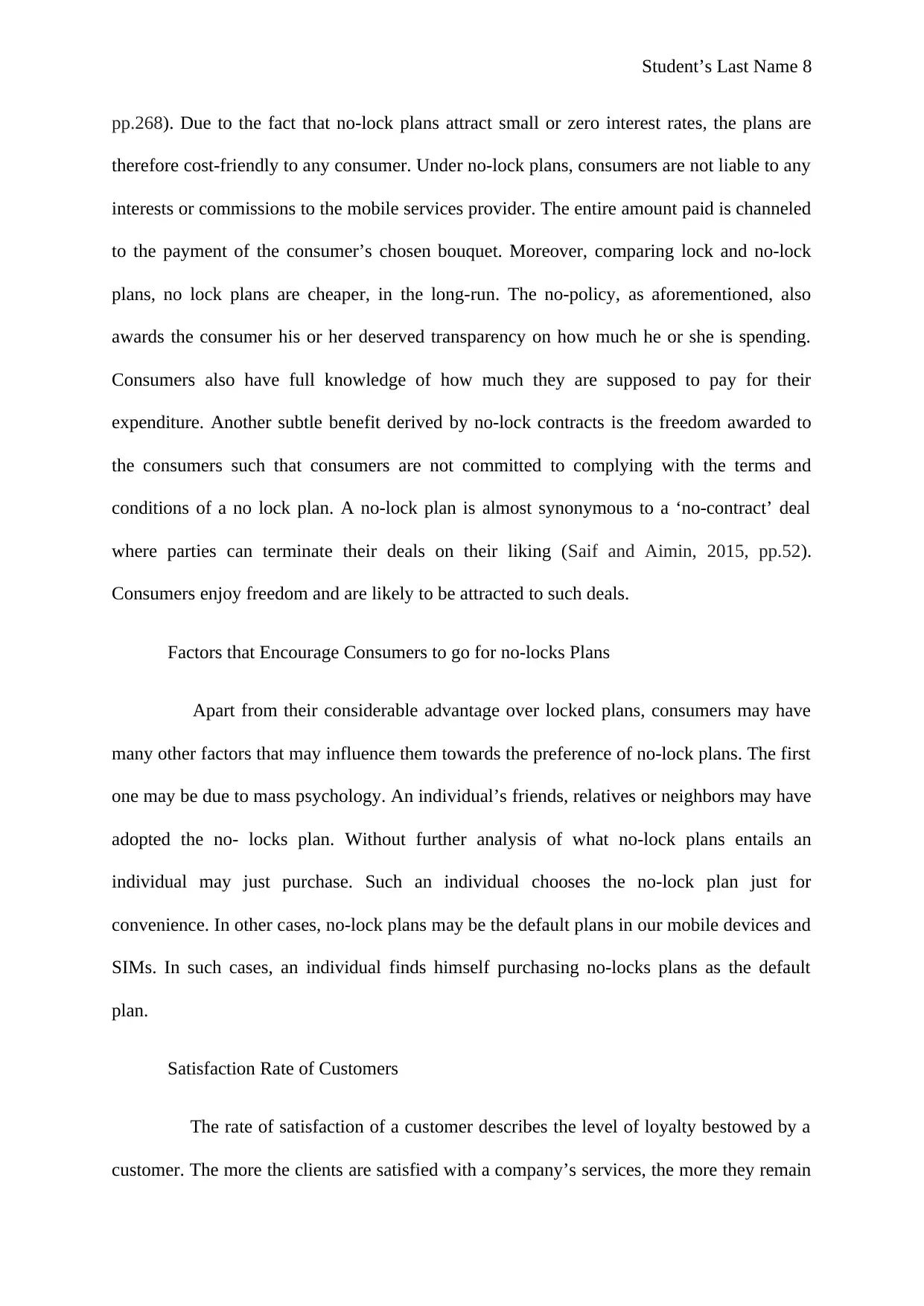
Student’s Last Name 8
pp.268). Due to the fact that no-lock plans attract small or zero interest rates, the plans are
therefore cost-friendly to any consumer. Under no-lock plans, consumers are not liable to any
interests or commissions to the mobile services provider. The entire amount paid is channeled
to the payment of the consumer’s chosen bouquet. Moreover, comparing lock and no-lock
plans, no lock plans are cheaper, in the long-run. The no-policy, as aforementioned, also
awards the consumer his or her deserved transparency on how much he or she is spending.
Consumers also have full knowledge of how much they are supposed to pay for their
expenditure. Another subtle benefit derived by no-lock contracts is the freedom awarded to
the consumers such that consumers are not committed to complying with the terms and
conditions of a no lock plan. A no-lock plan is almost synonymous to a ‘no-contract’ deal
where parties can terminate their deals on their liking (Saif and Aimin, 2015, pp.52).
Consumers enjoy freedom and are likely to be attracted to such deals.
Factors that Encourage Consumers to go for no-locks Plans
Apart from their considerable advantage over locked plans, consumers may have
many other factors that may influence them towards the preference of no-lock plans. The first
one may be due to mass psychology. An individual’s friends, relatives or neighbors may have
adopted the no- locks plan. Without further analysis of what no-lock plans entails an
individual may just purchase. Such an individual chooses the no-lock plan just for
convenience. In other cases, no-lock plans may be the default plans in our mobile devices and
SIMs. In such cases, an individual finds himself purchasing no-locks plans as the default
plan.
Satisfaction Rate of Customers
The rate of satisfaction of a customer describes the level of loyalty bestowed by a
customer. The more the clients are satisfied with a company’s services, the more they remain
pp.268). Due to the fact that no-lock plans attract small or zero interest rates, the plans are
therefore cost-friendly to any consumer. Under no-lock plans, consumers are not liable to any
interests or commissions to the mobile services provider. The entire amount paid is channeled
to the payment of the consumer’s chosen bouquet. Moreover, comparing lock and no-lock
plans, no lock plans are cheaper, in the long-run. The no-policy, as aforementioned, also
awards the consumer his or her deserved transparency on how much he or she is spending.
Consumers also have full knowledge of how much they are supposed to pay for their
expenditure. Another subtle benefit derived by no-lock contracts is the freedom awarded to
the consumers such that consumers are not committed to complying with the terms and
conditions of a no lock plan. A no-lock plan is almost synonymous to a ‘no-contract’ deal
where parties can terminate their deals on their liking (Saif and Aimin, 2015, pp.52).
Consumers enjoy freedom and are likely to be attracted to such deals.
Factors that Encourage Consumers to go for no-locks Plans
Apart from their considerable advantage over locked plans, consumers may have
many other factors that may influence them towards the preference of no-lock plans. The first
one may be due to mass psychology. An individual’s friends, relatives or neighbors may have
adopted the no- locks plan. Without further analysis of what no-lock plans entails an
individual may just purchase. Such an individual chooses the no-lock plan just for
convenience. In other cases, no-lock plans may be the default plans in our mobile devices and
SIMs. In such cases, an individual finds himself purchasing no-locks plans as the default
plan.
Satisfaction Rate of Customers
The rate of satisfaction of a customer describes the level of loyalty bestowed by a
customer. The more the clients are satisfied with a company’s services, the more they remain
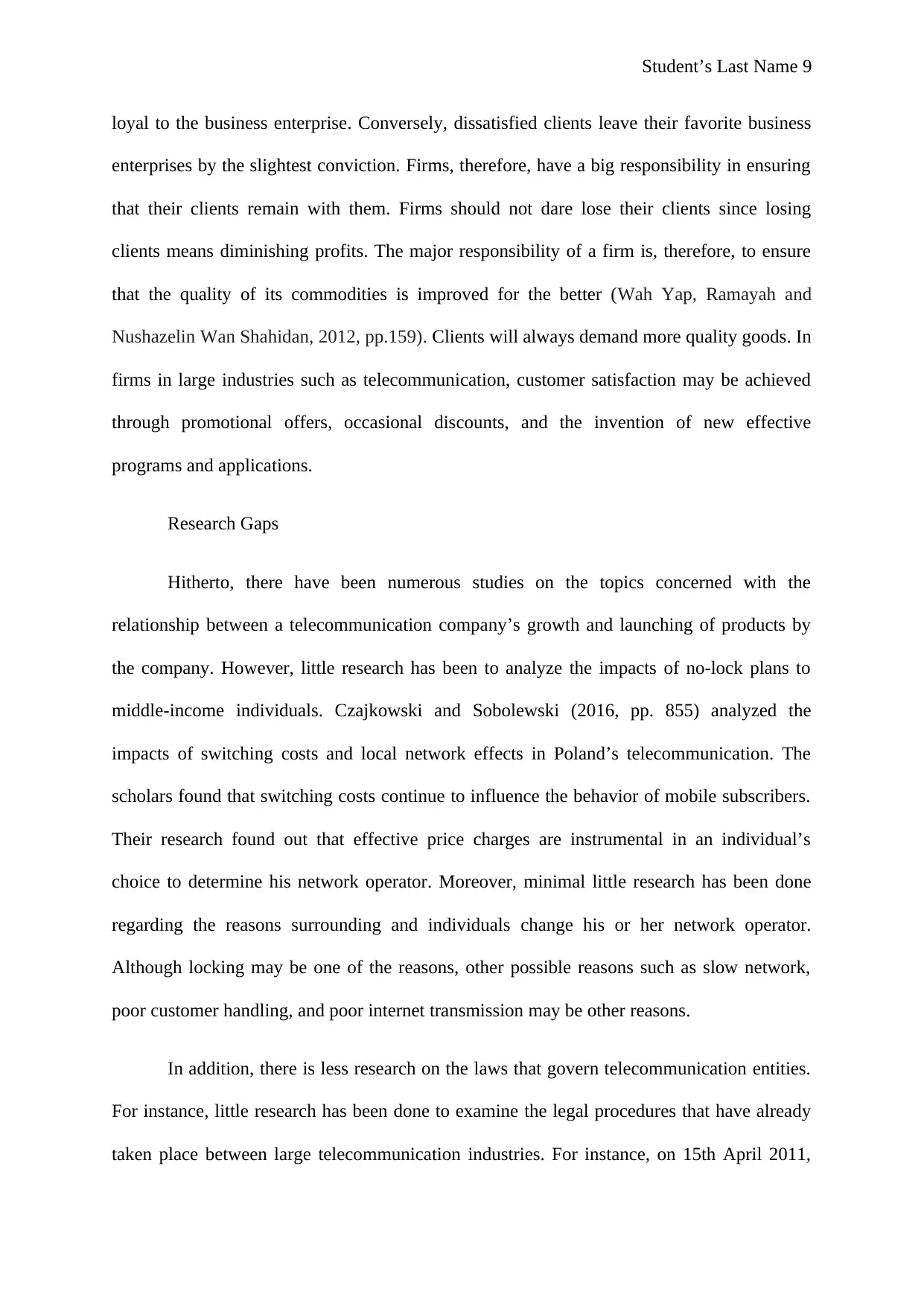
Student’s Last Name 9
loyal to the business enterprise. Conversely, dissatisfied clients leave their favorite business
enterprises by the slightest conviction. Firms, therefore, have a big responsibility in ensuring
that their clients remain with them. Firms should not dare lose their clients since losing
clients means diminishing profits. The major responsibility of a firm is, therefore, to ensure
that the quality of its commodities is improved for the better (Wah Yap, Ramayah and
Nushazelin Wan Shahidan, 2012, pp.159). Clients will always demand more quality goods. In
firms in large industries such as telecommunication, customer satisfaction may be achieved
through promotional offers, occasional discounts, and the invention of new effective
programs and applications.
Research Gaps
Hitherto, there have been numerous studies on the topics concerned with the
relationship between a telecommunication company’s growth and launching of products by
the company. However, little research has been to analyze the impacts of no-lock plans to
middle-income individuals. Czajkowski and Sobolewski (2016, pp. 855) analyzed the
impacts of switching costs and local network effects in Poland’s telecommunication. The
scholars found that switching costs continue to influence the behavior of mobile subscribers.
Their research found out that effective price charges are instrumental in an individual’s
choice to determine his network operator. Moreover, minimal little research has been done
regarding the reasons surrounding and individuals change his or her network operator.
Although locking may be one of the reasons, other possible reasons such as slow network,
poor customer handling, and poor internet transmission may be other reasons.
In addition, there is less research on the laws that govern telecommunication entities.
For instance, little research has been done to examine the legal procedures that have already
taken place between large telecommunication industries. For instance, on 15th April 2011,
loyal to the business enterprise. Conversely, dissatisfied clients leave their favorite business
enterprises by the slightest conviction. Firms, therefore, have a big responsibility in ensuring
that their clients remain with them. Firms should not dare lose their clients since losing
clients means diminishing profits. The major responsibility of a firm is, therefore, to ensure
that the quality of its commodities is improved for the better (Wah Yap, Ramayah and
Nushazelin Wan Shahidan, 2012, pp.159). Clients will always demand more quality goods. In
firms in large industries such as telecommunication, customer satisfaction may be achieved
through promotional offers, occasional discounts, and the invention of new effective
programs and applications.
Research Gaps
Hitherto, there have been numerous studies on the topics concerned with the
relationship between a telecommunication company’s growth and launching of products by
the company. However, little research has been to analyze the impacts of no-lock plans to
middle-income individuals. Czajkowski and Sobolewski (2016, pp. 855) analyzed the
impacts of switching costs and local network effects in Poland’s telecommunication. The
scholars found that switching costs continue to influence the behavior of mobile subscribers.
Their research found out that effective price charges are instrumental in an individual’s
choice to determine his network operator. Moreover, minimal little research has been done
regarding the reasons surrounding and individuals change his or her network operator.
Although locking may be one of the reasons, other possible reasons such as slow network,
poor customer handling, and poor internet transmission may be other reasons.
In addition, there is less research on the laws that govern telecommunication entities.
For instance, little research has been done to examine the legal procedures that have already
taken place between large telecommunication industries. For instance, on 15th April 2011,
⊘ This is a preview!⊘
Do you want full access?
Subscribe today to unlock all pages.

Trusted by 1+ million students worldwide
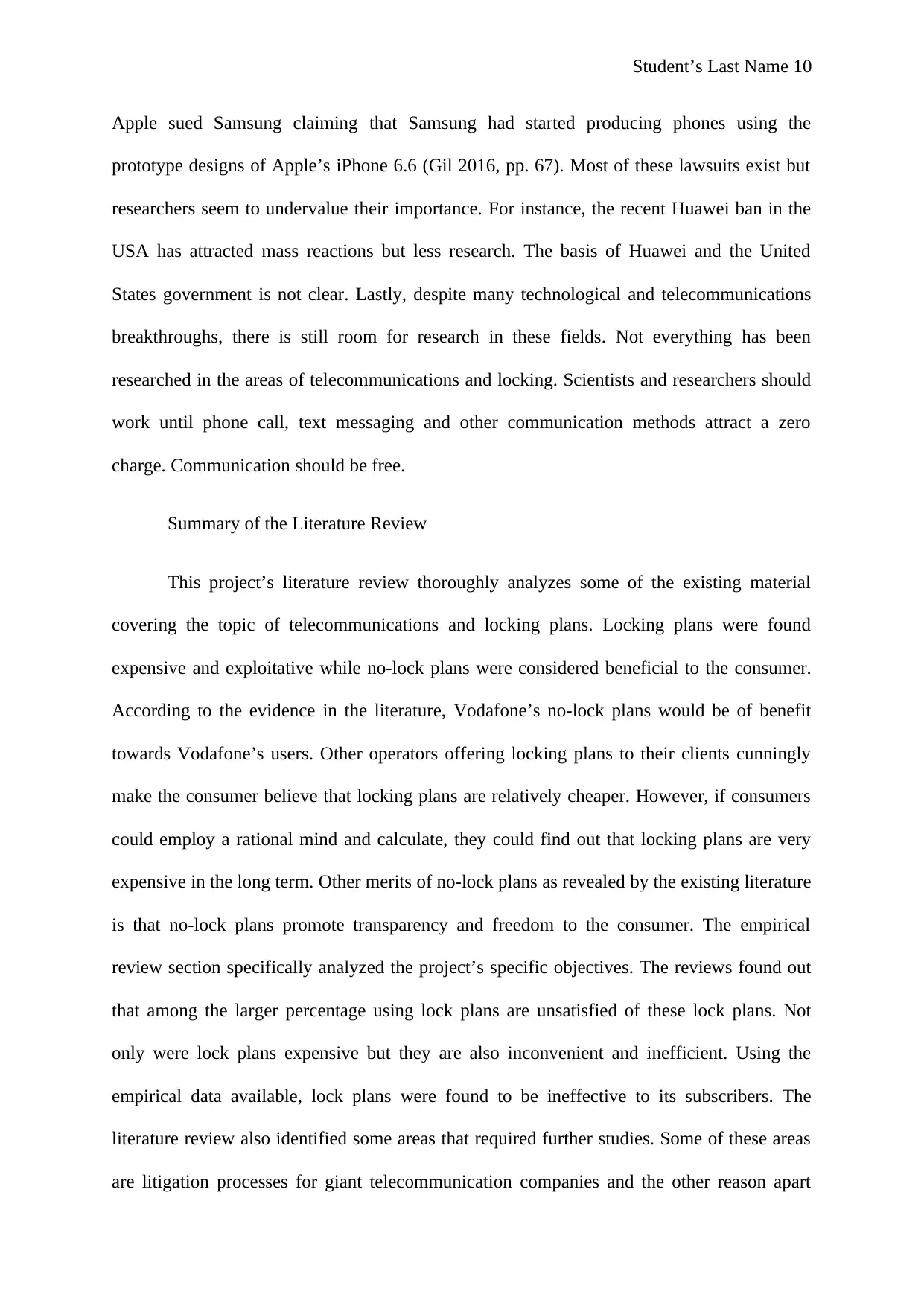
Student’s Last Name 10
Apple sued Samsung claiming that Samsung had started producing phones using the
prototype designs of Apple’s iPhone 6.6 (Gil 2016, pp. 67). Most of these lawsuits exist but
researchers seem to undervalue their importance. For instance, the recent Huawei ban in the
USA has attracted mass reactions but less research. The basis of Huawei and the United
States government is not clear. Lastly, despite many technological and telecommunications
breakthroughs, there is still room for research in these fields. Not everything has been
researched in the areas of telecommunications and locking. Scientists and researchers should
work until phone call, text messaging and other communication methods attract a zero
charge. Communication should be free.
Summary of the Literature Review
This project’s literature review thoroughly analyzes some of the existing material
covering the topic of telecommunications and locking plans. Locking plans were found
expensive and exploitative while no-lock plans were considered beneficial to the consumer.
According to the evidence in the literature, Vodafone’s no-lock plans would be of benefit
towards Vodafone’s users. Other operators offering locking plans to their clients cunningly
make the consumer believe that locking plans are relatively cheaper. However, if consumers
could employ a rational mind and calculate, they could find out that locking plans are very
expensive in the long term. Other merits of no-lock plans as revealed by the existing literature
is that no-lock plans promote transparency and freedom to the consumer. The empirical
review section specifically analyzed the project’s specific objectives. The reviews found out
that among the larger percentage using lock plans are unsatisfied of these lock plans. Not
only were lock plans expensive but they are also inconvenient and inefficient. Using the
empirical data available, lock plans were found to be ineffective to its subscribers. The
literature review also identified some areas that required further studies. Some of these areas
are litigation processes for giant telecommunication companies and the other reason apart
Apple sued Samsung claiming that Samsung had started producing phones using the
prototype designs of Apple’s iPhone 6.6 (Gil 2016, pp. 67). Most of these lawsuits exist but
researchers seem to undervalue their importance. For instance, the recent Huawei ban in the
USA has attracted mass reactions but less research. The basis of Huawei and the United
States government is not clear. Lastly, despite many technological and telecommunications
breakthroughs, there is still room for research in these fields. Not everything has been
researched in the areas of telecommunications and locking. Scientists and researchers should
work until phone call, text messaging and other communication methods attract a zero
charge. Communication should be free.
Summary of the Literature Review
This project’s literature review thoroughly analyzes some of the existing material
covering the topic of telecommunications and locking plans. Locking plans were found
expensive and exploitative while no-lock plans were considered beneficial to the consumer.
According to the evidence in the literature, Vodafone’s no-lock plans would be of benefit
towards Vodafone’s users. Other operators offering locking plans to their clients cunningly
make the consumer believe that locking plans are relatively cheaper. However, if consumers
could employ a rational mind and calculate, they could find out that locking plans are very
expensive in the long term. Other merits of no-lock plans as revealed by the existing literature
is that no-lock plans promote transparency and freedom to the consumer. The empirical
review section specifically analyzed the project’s specific objectives. The reviews found out
that among the larger percentage using lock plans are unsatisfied of these lock plans. Not
only were lock plans expensive but they are also inconvenient and inefficient. Using the
empirical data available, lock plans were found to be ineffective to its subscribers. The
literature review also identified some areas that required further studies. Some of these areas
are litigation processes for giant telecommunication companies and the other reason apart
Paraphrase This Document
Need a fresh take? Get an instant paraphrase of this document with our AI Paraphraser
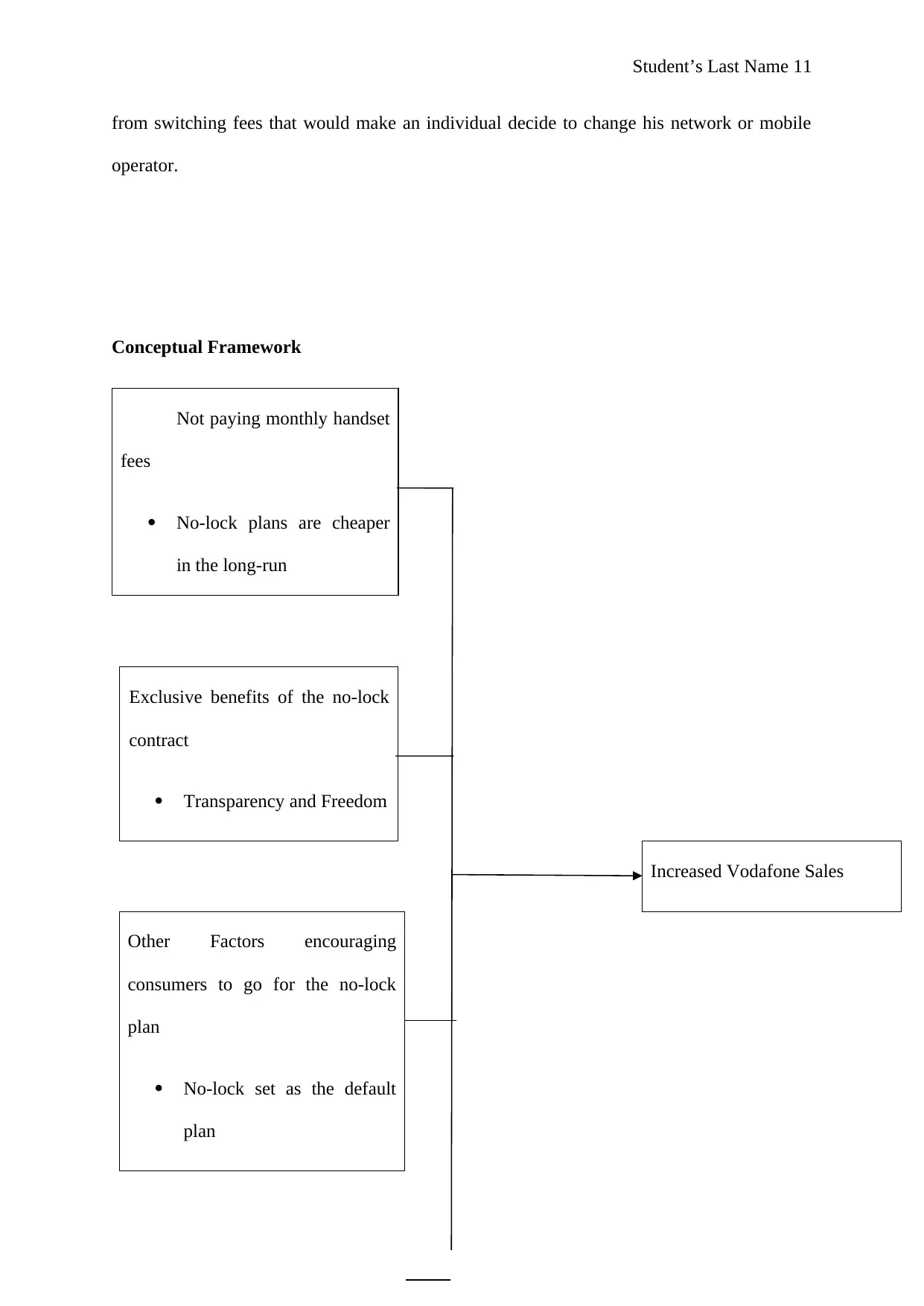
Student’s Last Name 11
from switching fees that would make an individual decide to change his network or mobile
operator.
Conceptual Framework
Not paying monthly handset
fees
No-lock plans are cheaper
in the long-run
Exclusive benefits of the no-lock
contract
Transparency and Freedom
Increased Vodafone Sales
Other Factors encouraging
consumers to go for the no-lock
plan
No-lock set as the default
plan
from switching fees that would make an individual decide to change his network or mobile
operator.
Conceptual Framework
Not paying monthly handset
fees
No-lock plans are cheaper
in the long-run
Exclusive benefits of the no-lock
contract
Transparency and Freedom
Increased Vodafone Sales
Other Factors encouraging
consumers to go for the no-lock
plan
No-lock set as the default
plan
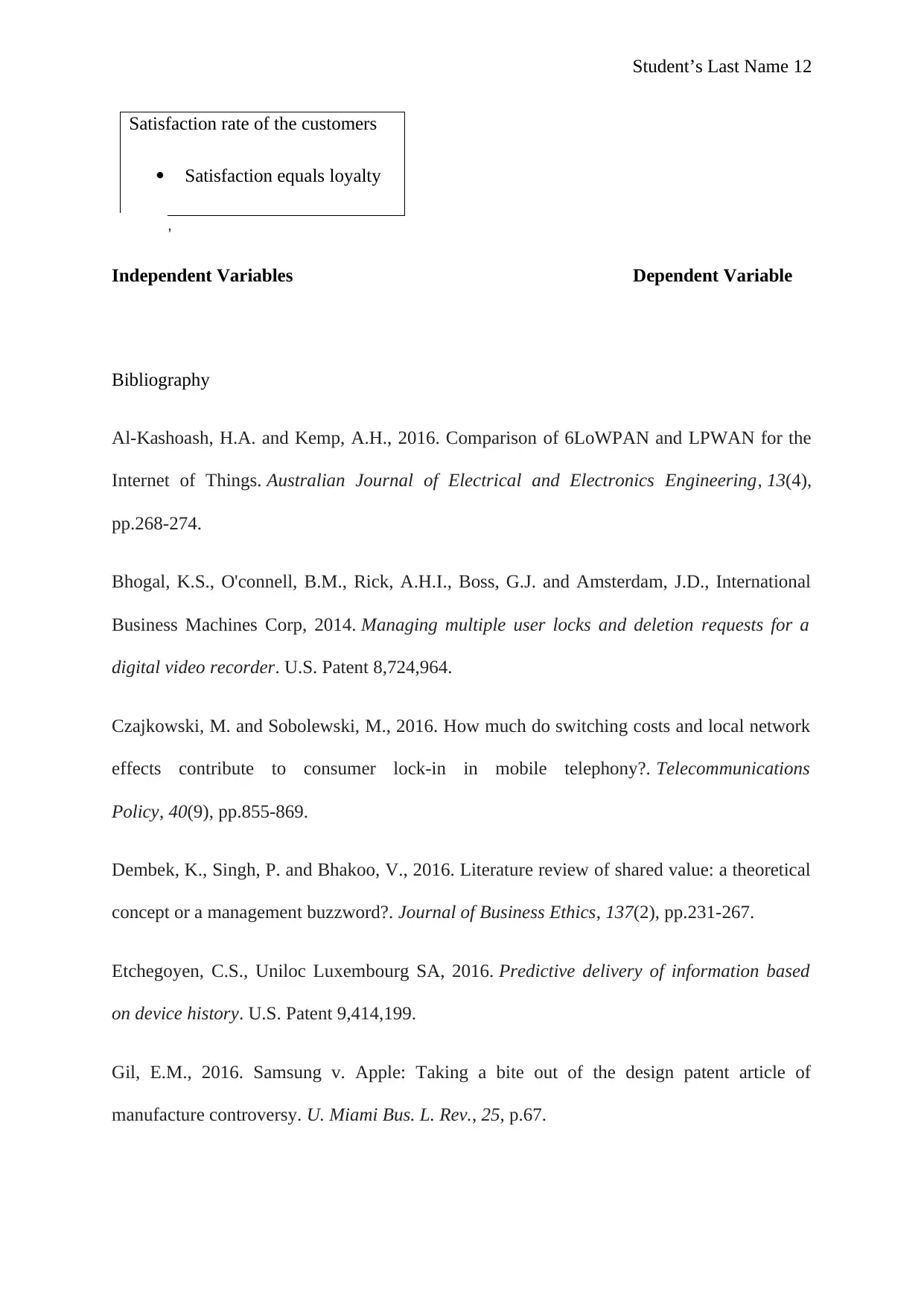
Student’s Last Name 12
Satisfaction rate of the customers
Satisfaction equals loyalty
,
Independent Variables Dependent Variable
Bibliography
Al-Kashoash, H.A. and Kemp, A.H., 2016. Comparison of 6LoWPAN and LPWAN for the
Internet of Things. Australian Journal of Electrical and Electronics Engineering, 13(4),
pp.268-274.
Bhogal, K.S., O'connell, B.M., Rick, A.H.I., Boss, G.J. and Amsterdam, J.D., International
Business Machines Corp, 2014. Managing multiple user locks and deletion requests for a
digital video recorder. U.S. Patent 8,724,964.
Czajkowski, M. and Sobolewski, M., 2016. How much do switching costs and local network
effects contribute to consumer lock-in in mobile telephony?. Telecommunications
Policy, 40(9), pp.855-869.
Dembek, K., Singh, P. and Bhakoo, V., 2016. Literature review of shared value: a theoretical
concept or a management buzzword?. Journal of Business Ethics, 137(2), pp.231-267.
Etchegoyen, C.S., Uniloc Luxembourg SA, 2016. Predictive delivery of information based
on device history. U.S. Patent 9,414,199.
Gil, E.M., 2016. Samsung v. Apple: Taking a bite out of the design patent article of
manufacture controversy. U. Miami Bus. L. Rev., 25, p.67.
Satisfaction rate of the customers
Satisfaction equals loyalty
,
Independent Variables Dependent Variable
Bibliography
Al-Kashoash, H.A. and Kemp, A.H., 2016. Comparison of 6LoWPAN and LPWAN for the
Internet of Things. Australian Journal of Electrical and Electronics Engineering, 13(4),
pp.268-274.
Bhogal, K.S., O'connell, B.M., Rick, A.H.I., Boss, G.J. and Amsterdam, J.D., International
Business Machines Corp, 2014. Managing multiple user locks and deletion requests for a
digital video recorder. U.S. Patent 8,724,964.
Czajkowski, M. and Sobolewski, M., 2016. How much do switching costs and local network
effects contribute to consumer lock-in in mobile telephony?. Telecommunications
Policy, 40(9), pp.855-869.
Dembek, K., Singh, P. and Bhakoo, V., 2016. Literature review of shared value: a theoretical
concept or a management buzzword?. Journal of Business Ethics, 137(2), pp.231-267.
Etchegoyen, C.S., Uniloc Luxembourg SA, 2016. Predictive delivery of information based
on device history. U.S. Patent 9,414,199.
Gil, E.M., 2016. Samsung v. Apple: Taking a bite out of the design patent article of
manufacture controversy. U. Miami Bus. L. Rev., 25, p.67.
⊘ This is a preview!⊘
Do you want full access?
Subscribe today to unlock all pages.

Trusted by 1+ million students worldwide
1 out of 13
Your All-in-One AI-Powered Toolkit for Academic Success.
+13062052269
info@desklib.com
Available 24*7 on WhatsApp / Email
![[object Object]](/_next/static/media/star-bottom.7253800d.svg)
Unlock your academic potential
Copyright © 2020–2025 A2Z Services. All Rights Reserved. Developed and managed by ZUCOL.


